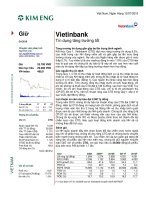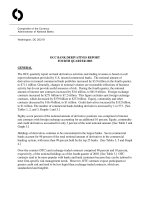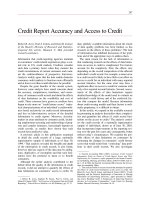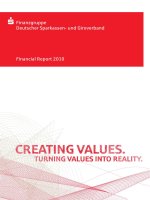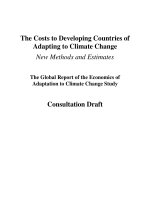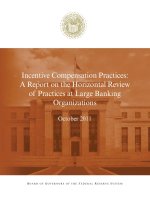Trm report vietinbank
Bạn đang xem bản rút gọn của tài liệu. Xem và tải ngay bản đầy đủ của tài liệu tại đây (200.49 KB, 23 trang )
Hanoi University
FACULTY OF MANAGEMENT AND TOURISM
COURSE: TREASURY MANAGEMENT
Vietnam Joint Stock Commercial Bank for Industry and Trade
Tutorial 2 – Group 2
Tutor: Ms. Nguyen Thi Minh Hang
Students: Nguyen Thi Thanh Hang – 1904040040
Do Thi Mai Trang – 1904040118
Nguyen Thuy Trang – 1904040121
Vu Trang Tho - 1904040115
ABSTRACT
In recent years, financial institutions and the services they provide have become more
internationalized, and most financial service providers have grown in size and scale complexity.
This leads to an urgent requirement to reduce risks and increase income for banking activities.
VietinBank (Vietnam Joint Stock Commercial Bank for Industry and Trade) is now known as one
of the four banks that play a key role in leading Vietnam's economy. This report is intended to
provide a detailed summary of Vietinbank's performance through current status, credit risk,
interest rate risk, and liquidity risk in the previous 5 years (2018-2022). In addition, the
parameters will be selected and studied, thereby showing the impact of changes in liquidity status
and interest rates on VietinBank's income and capital. At the same time, this report shows some
hedging proposal in order to reduce some current risk of Vietinbank.
TABLE OF CONTENTS
I.
INTRODUCTION....................................................................................................................4
II.
MARKET CONDITION......................................................................................................4
1. Macroeconomics factors and overall banking industry....................................4
2. Vietinbank overall indicators......................................................................................5
III.
RISK MANAGEMENT........................................................................................................7
1.
Credit risk..............................................................................................................................7
2.
Interest rate risk.....................................................................................................................8
3.
Liquidity..............................................................................................................................10
3.1. ALCO...........................................................................................................................10
3.2.
IV.
1.
SCENARIOS ANALYSIS...................................................................................................12
Income impact.....................................................................................................................12
1.1.
2.
Changes in interest rate................................................................................................13
Capital Impact.....................................................................................................................14
2.1.
V.
Liquidity ratio...............................................................................................................11
Changes in liquidity.....................................................................................................15
HEDGING PROPOSAL........................................................................................................16
1. Forward Rate Agreement (FRAs).............................................................................16
2. Options..............................................................................................................................17
3. Future (forward) contracts.........................................................................................17
4. Swaps................................................................................................................................17
VI.
CONCLUSION...................................................................................................................18
I.INTRODUCTION
One of the biggest commercial banks in Vietnam with many years of
expertise in the financial industry is the Vietnam Joint Stock Commercial Bank
for Industry and Trade (VietinBank). Vietnam Investment and Development
Bank (VIDB), the earlier version of today's VietinBank, was founded in 1988.
Vietnam Joint Stock Commercial Bank for Industry and Trade (VietinBank) has
been the new name of Vietnam Investment and Development Bank (VIDB)
since
2008.
With total assets of more than 1.81 trillion VND and a nationwide customer
service network that includes more than 1,000 transaction sites throughout
63 provinces and cities, VietinBank is now one of the biggest banks in
Vietnam. Loans, deposits, payments, credit cards, stocks, insurance, and
goods and services for businesses are among the many financial services and
products that VietinBank provides.
After 35 years of operation and growth, VietinBank has established itself as
one of the most trustworthy addresses for clients both in Vietnam and around
the world. The banking and finance industry has seen significant successes
for VietinBank. For many years, it has been recognized as the best bank in
Vietnam and Southeast Asia. Finance Asia Magazine named it "Vietnam's Best
Service Bank," and it has an A+ rating from Standard & Poor's. Additionally,
Vietinbank got the title of "Most Innovative Digital Bank in Asia-Pacific" in
2022.
Since its establishment, VietinBank has always maintained its core values,
which include fulfilling customers' needs effectively, continuously aiming to
improve the quality of products and services, managing sustainable business
growth with social responsibility, and maintaining the bank's reputation in
society as a whole. As a result, VietinBank has earned its position as the top
bank in the Vietnamese banking sector by offering modern, innovative,
practical, and global banking and financial services.
II. MARKET CONDITION
1. Macroeconomics factors and overall banking industry
The current state of the economy and future trends have an impact on the
success and strategy of a bank, the main factors that many banks often
analyze are the economy's growth rate, interest rates, interest rates, and
interest rates. exchange rates, inflation, and capital mobilization. From 2020
onwards, the banking industry will face difficulties when the credit growth of
the whole industry will only reach 12.1%, the lowest in recent years due to
the impact of the epidemic on the economy, causing credit demand to
decline. Although banks have limited personal lending during this period to
avoid bad debts, such a high credit growth rate proves that credit demand
has recovered very well since the end of 2020. In 2022, the world economic
situation with many complicated fluctuations such as oil price, US dollar
price, the gold price fluctuates up and down, food price fever soars like the
Fed
interest
rate
change
event
–
The
US
Federal
Reserve,
many
unprecedented developments such as military conflicts in Russia - Ukraine,
record-high inflation in many countries; Natural disasters persisted on a large
scale in many regions. Facing that situation, major countries adjusted their
monetary policies towards tightening, applying all measures to ensure energy
security.. directly to the global economy, including Vietnam. However,
Vietnam's economy has had a strong recovery, achieving positive and
comprehensive results. GDP growth in 2022 will reach 8.02%, which is the
highest growth rate in the past 10 years and exceeds the set target of 66.5%. Major balances are always guaranteed, and the macro foundation
continues to remain stable. In addition, actions to tighten the money supply
such as sucking up VND through OMO channel and selling foreign currencies
to control exchange rate fluctuations are supported. expected to continue in
the short term. Actively contributing to the achievements of the economy,
the State Bank has balanced key macroeconomic targets and implemented
synchronous and flexible solutions to manage monetary policy, stabilize
exchange rates, and concurrently regulate monetary policy. inflation,
ensuring operational safety for the financial system. Credit construction of
the whole industry in 2022 will increase by about 14.2%, meeting the capital
needs of the economy. At the same time, the SBV continues to orient and
direct
commercial
banks
to
use
reasonable
costs,
focus
on
digital
transformation, make efforts to reduce lending interest rates, and support
businesses and operators to restore production activities doing business after
the prolonged epidemic period.
2. Vietinbank overall indicators
Due to the COVID-19 pandemic, the banking industry in Vietnam has
changed dramatically, and so has VietinBank. The table below shows an
overview of the financial factors, namely total assets, gross loan, funding,
and equity of VietinBank for 5 years from 2018 to 2022
Financial
factor (VND
billion)
2018
2019
2020
2021
2022
Total asset
1,64,434
1,240,71
1
1,341,43
6
1,531,587
1,808,42
9
Revenue
22,212
33,199
35,580
41,778
47,792
Net income
6,559
11,781
17,120
17,589
20,946
Shareholders’
Equity
67,316
77,355
85,439
93,650
108,167
Total Funding
825,816
892,785
990,331
1,161,848
1,249,17
6
Gross Loans
888,216
953,178
1,027,54
1
1,141,454
1,245,05
7
Fee and
Commission
Income
5,964
7,888
8,359
9,573
12,399
Figure 1: Vietinbank’s financial indicators
Despite the declining trend of the world economy, Vietinbank has achieved
impressive achievements in most aspects of operations, especially in 2022.
The total assets of VietinBank reached VND 1,691 trillion, an increase of
10 .4% compared to the end of 2021 and an increase of approximately 39.9%
compared to 2018. Customer deposits reached VND 1,249 trillion, an
increase of 3.8% compared to the end of 2021 and 54.3% compared to 2018.
In general, in 2022, with the continued proactive restructuring of all aspects
of operations, drastic transformation of business models, restructuring of
outstanding loans, increase of non-interest income, optimization of control,
and efficiency. capital and operating costs of the bank. Consolidated EBT in
2022 reached VND 20,946 billion, an increase of 19.1% compared to 2021,
creating a strong financial resource for VietinBank to continue to promote
well its role as a key State-owned commercial bank, a pillar of the economy,
playing a key role in the economy. contribute greatly to the State budget and
the country's socio-economic development in the coming time. Total
operating income in 2022 will reach VND 64.6 trillion (+21.5%). Net interest
income increased by 15% due to VietinBank's optimal structure of credit
portfolio coupled with risk control, net income from foreign exchange
business continued to grow strongly by 97%, because VietinBank continue to
diversify the structure of foreign exchange products, and promote the
development of new customers in the market. Which, cash deposits to CASA
have improved compared to the end of 2021 (CASA balance reached VND
240 trillion, up 2.7% compared to the end of 2021, accounting for 19.9% of
total customer deposits). Deposits from customers still account for a large
proportion, 75% of the total capital, which is a factor of high-quality capital.
Loans to customers reached VND 1,245 trillion, an increase of 9.5%
compared to the end of 2021. Some other financial indicators such as ROA,
ROE, CAR are placed under strict control. VietinBank has a strong capital
foundation for future growth. Equity reached VND108.167 billion (up 46.9%)
from the end of 2018 to the end of 2022, the Basel II consolidated CAR ratio
of 8.5% is considered low among banks listed on HOSE, However, it still
meets the requirement of over 8% according to Circular 41.
III. RISK MANAGEMENT
1. Credit risk
According to the Corporate Finance Institute, credit risk is the risk that borrowers or
counterparties fail to meet the obligations specified in the contract or default to fulfill their
commitments. In other words, it refers to the risk that the bank cannot receive the loan’s principal
and interest payment. Besides, credit risk is considered to be one of the biggest risks for banks. It
can arise from individual loans, business loans, mortgages, car loans, credit cards… and
eventually derivatives and guarantee activities.
The ratio that helps to control credit risk effectively is NPL (non-performing - loans ratio), also
known as the percentage of non-performing loans in a bank's loan portfolio divided by the total
amount of outstanding loans held by the bank. As stated in the Annual Report of VietinBank in
2021, since the beginning of 2015, credit institutions and foreign bank branches have been
required to use the most updated information from the Credit Information Centre (“CIC”) about
the loan group of clients at the time of loan classification to modify the classification group of
loans and off-balance sheet items (This regulation does not apply to the results of loan
classification for customers of the Vietnam Development Bank provided by CIC). Accordingly,
loan portfolios are allocated based on the level of risk as follows: Current, Special Mention, Substandard, Doubtful, and Loss while Non-performing loans are only included in Substandard,
Doubtful, and Loss.
Year
2018
2019
2020
2021
2022
1. Current (Overdue less
than 10 days)
846,022,474
918,780,095
1,002,771,068
1,104,465,335
1,229,062,250
2. Special mention
(Overdue from 10
days to 90 days)
5,194,126
5,677,439
2,965,260
11,901,967
29,958,469
3. Sub-standard
(Overdue from 90
days to 180 days)
2,139,221
2,062,615
1,891,960
7,095,731
7,305,070
4. Doubtful (Overdue
from 180 days to 360
days)
2,016,689
1,546,701
1,627.523
2,003,066
2,261,011
5. Loss (Overdue more
than 360 days)
9,553,438
7,204,095
6,077,459
5,210,668
6,234,899
Non-performing loan =
(3) + (4) + (5)
13,709,348
10,813,411
9,596,942
14,300,465
15,800,980
Total = (1) + (2) + ( 3) +
(4) + (5)
864,925,948
935,207,945
1,015,333,270
1,130,667,767
1,274,821,709
NPL
1.585%
1.156%
0.945%
1.256%
1.239%
Figure 2: Non-performing loan ratio
Unit: Million VND
Overall, the NPL ratio witnessed a downward trend of 0.64% in the 3 years period from 2018 to
2020 due to the significant decrease in debts that are overdue for a period of more than 360 days
and the remarkable rise of current loans. From 2020 to 2021, this ratio increased moderately from
0.945% to 1.265% because of the increase of nearly six times in the number of debts overdue
from 3 months to 6 months. In 2022, this ratio experienced a slight decline of 0.025% as the
number of current loans and special mention loans grew.
To control credit risk, there are some tools used by VietinBank as mentioned in the Annual
Report. In terms of credit activities, the Bank manages and controls credit risk by setting limits
for credit risk control that are in line with the Bank’s risk capacity for each client, segment,
geographical area, and industry. A credit quality review process is also established to identify the
potential changes in the financial position as well as the solvency of counterparties based on the
qualitative and quantitative elements. The limit for credit risk control corresponding to each
counterparty is established based on the risk rating assigned by the credit rating system. This risk
rating can be adjusted and updated frequently. For investment activities/interbank lending
activities, the Bank controls and manages risks by setting interbank investment limits for each
distinct counterparty based on the analysis and evaluation of the Bank for that counterparty’s risk
level. These limits are determined by the Financial Institution Committee and carried out by the
Treasury Trading Department.
2. Interest rate risk
Interest rate risk is the possibility of income or asset value being affected when the market
interest rate fluctuates. Interest rate risk represents one of the important risks that a bank might
cope with. It can be concluded that interest rate changes will have a negative effect on a bank’s
revenue, asset and liability, and off-balance sheet items. In this paper, the Dollar Gap is used to
evaluate VietinBank’s exposure to interest rate risk. The interest-sensitive gap (IS GAP) or
Dollar gap is well-known as the difference between interest-sensitive assets (RSA) and interestsensitive liabilities (RSL). The dollar gap ($GAP) is calculated by taking Rate-sensitive assets
minus Rate-sensitive liabilities.
$GAP = Rate-sensitive assets - Rate-sensitive liabilities
Year
2018
2019
2020
2021
2022
Deposits in the
State Bank of
23,182,208
24,873,714
57,616,650
23,383,443
29,727,110
Vietnam
Deposits and
credit to other
credit institutions
130,512,012
129,388,518
102,532,818
149,316,646
242,431,953
Investment in
securities
102,100,093
104,615,279
114,941,998
177,544,548
180,312,848
Loans to
customers
851,865,984
922,325,251
1,002,750,890
1,104,872,665
1,245,057,876
RSA
1,107,660,297
1,181,202,762 1,277,842,256
1,455,117,302
1,697,529,787
Borrowings to the
State Bank of
Vietnam
62,600,159
20,602,893
44,597,188
33,294,404
104,779,302
Deposits and
borrowings from
other credit
institutions
111,399,612
109,483,069
128.519,115
138,833,846
209,429,843
Customer deposits
825,816,119
892,785,228
990,331,285
1,161,848,113
1,249,176,034
Valuable papers
46,216,359
57,066,353
59,875,570
64,496,785
91,370,419
RSL
1,046,032,249
1,398,473,148
1,654,755,598
$GAP
61,628,048
56,644,154
24,774,189
1,129,937,533 1,223,323,158
51,265,229
51,265,229
Figure 3: Dollar gap
Unit: Million VND
From the table, it can be seen that VietinBank had positive Dollar Gaps during the five years as
its rate-sensitive assets were always greater than its rate-sensitive liabilities. Therefore, the Bank
was considered to be asset-sensitive. In addition, there was also a fluctuation in the Dollar Gap. It
decreased significantly in 2019 then increased slightly during the next 2-year period before
witnessing a remarkable decline in 2022. A positive gap shows that growth in market interest
rates creates an increase in net interest margins and vice versa.
In accordance with VietinBank’s annual report, the interest rate risk of the Bank can be derived
from investment activities, capital mobilization, and lending activities. The market's movement
and the bank's cost of capital are the two main determinants of the investment interest rate for
interbank short-term lending activities. For capital mobilization activities, interest rates are set in
accordance with the market price, the business orientation of the Bank’s management, the Bank’s
capital balance, and the regulations of the State Bank of Vietnam. For lending activities, to secure
its competitiveness and efficiency the Bank determines lending interest rates following the
coverage of cost of capital, management cost, riskiness, value of collateral, and market interest
rate.
The lending interest rate floor for each period is regulated by the Head Office. As long as the
lending interest rates are not lower than the set floor rate and the annual budgeted profit is
guaranteed, branches may determine the rates for each customer each period based on credit risk
analysis and assessment. Besides, due to the capital structure mainly comprising funds with short
interest rate repricing terms, the Bank requires that all long-term and medium-term loans’ interest
must be floating (interest rates are not fixed during the whole loans’ periods) to minimize
possible arising interest rate risk. In addition, the Bank mandates that all long-term and mediumterm loans' interest be floating rate (interest rates are not fixed for the entire loans' periods) in
order to minimize any rise in interest rate risk. This is because the capital structure mainly
comprises funds with short interest rate repricing terms.
3. Liquidity
Liquidity risk is defined as the risk that VietinBank has difficulties in meeting obligations
associated with its financial liabilities. Liquidity risk arises when the Bank might be unable to
meet its payment obligations at their due dates or when the Bank has to pay at a higher cost to
meet its obligations. In order to proactively take action in the event of market volatility, the Bank
has issued some regulations and procedures on liquidity management, consisting of guidelines for
managing liquidity gaps through maturity, liquidity risk ratios, stress test scenarios, and backup
plans.
3.1. ALCO
One of the major topics to be discussed at monthly ALCO Council meetings is the bank's fund
balance and liquidity. Meetings of the Risk Management Committee and the Risk Management
Council also examine and report on the compliance of the liquidity risk appetite and risk
capacity. The Board of Directors and Management receive recommendations from the Risk
Management Committee/ALCO/Risk Management Council based on analysis and review for
how to most effectively and safely preverse the bank’s solvency.
Total assets
Up to 1
month
From 1 to 3
months
From 3 to 12
months
From 1 to 5
years
Over 5 years
350,285,860
334,724,247
564,292,921
229,908,613
313,526,430
Total liabilities
458,584,038
Net liquidity
Cummulative Gap
250,158,536
677,192,453
275,752,193
36,536,097
(108,298,178) 84,565,711
(112,899,532)
(45,843,580)
275,990,333
(108,298,178) (23,732,467)
(136,631,999)
(182,475,579)
93,514,754
Figure 4: Liquidity Gap in 2022
Unit: Million VND
Overall, the net liquidity of 1 month, from 3 to 5 months, and from 1 to 5 years maturities was
negative while 1-3 months and over 5 years terms were greatly positive. The biggest gap
belonged to over 5 years of maturity which was nearly 300,000,000 million VND. This can be
explained by the effort of the Vietnamese government in supporting businesses to recover from
Covid pandemic. Specifically, the Bank had reduced lending interest rates by 2% annually for
firms in the areas serving people’s basic needs. On the other hand, the Bank also cut its deposit
interest rates due to a credit growth slowdown in the recovery of the economy after the pandemic
(The Ministry of Finance). The total cumulative gap was more than 90,000,000 VND indicating
that VietinBank had sufficient cash on hand to ensure that they are able to meet customer deposit
withdrawals at any time and not have too many deposits loaned out.
3.2.
Liquidity ratio
Apart from the liquidity gap, many other liquidity ratios are essential to evaluate the bank's
liquidity risk. In this paper, the Loan-to-deposit ratio (LDR) will be used to assess the liquidity
risk of VietinBank.
LDR = Total Loan / Total Deposit
Loan-to-deposit ratio
2018
2019
2020
2021
2022
88.0%
88.1%
86.1%
81.9%
81.8%
0.10%
-2.00%
-4.20%
-0.1%
90%
85%
85%
85%
Change in LDR
SBV requirement for
state-owned
commercial banks
90%
Figure 4: Loan-to-deposit ratio
The LDR ratio of VietinBank remained at around 88% which was below the maximum
requirement of 90% in the first 2 years. In the next year, it exceeded the ceiling rate of 85% due
to the rapid change in the LDR ratio requirement set by SBV for state-owned commercial banks
in 2020. However, as stated by VNDIRECT’s Hien, the LDR ratio is not only the indication to
evaluate the liquidity risk of a bank, commercial banks usually have this ratio high. An example
of this is that most banks have this ratio exceeding 85%, especially Techcombank, and VPBank.
From 2021 to 2022, this ratio was controlled effectively by VietinBank to be steadily lower than
85%.
IV. SCENARIOS ANALYSIS
1. Income impact
Year
2018
2019
2020
2021
2022
Profit before tax
6,730,402
11,780,993
17,084,849 17,589,156
20,946,059
Owners' net profit
5,413,949
13,693,588
9,461,267
14,088,760
16,775,074
EPS
1,454
3,678
1,966
2,510
3,491
Figure 5: Vietinbank’s Income Statement
Unit: Million VND
Vietinbank's profit after tax has climbed over the years, reaching a peak in 2022 with VND
20,946 billion, an increase of 19.1% over 2021, as can be seen from the statistics in the above
table. This outcome was made possible by VietinBank's achievement of profitable business
outcomes in all facets of operations in 2022. To be more specific, in 2022, VietinBank actively
implemented business solutions in sync, making efforts to promote innovation and restructuring,
comprehensively operating in the direction of strongly transforming growth model, rapidly
shifting income structure, implementing customer-centric strategy, determining competitive
methods in the direction of focusing on developing financial solutions modern system, improve
consulting capacity, service quality, and meet the financial needs of customers to the maximum.
Owners' net profit and earnings per share (EPS) both increased during this period, with Owners'
net profit rising by 209.85% from 5,413,949 million in 2018 to 16,775,074 million in 2022 and
EPS rising from 1,454 million in 2018 to 3,491 million in 2022, regardless of some fluctuations
over the years. All of the above indications indicate that Vietinbank has generated profits over the
previous five years, despite a challenging time owing to the Covid-19 epidemic.
1.1.
Changes in interest rate.
In actuality, banks have highly sensitive views about interest. The profitability and asset value of
banks will be impacted in different ways by each change in interest rates. In other words,
whenever interest rates change, interest income and expenses also change. As a result, one of the
most crucial indicators of banks, Net Interest Income, may be in danger. Therefore, it's critical to
accurately identify, quantify, track, and manage interest rate risk exposure. In light of this, we
used Dollar Gap: An Analysis to determine how Vietinbank's NII would vary if interest rates rose
or fell by 1% to 2%.
ΔNII = $GAP * ΔInterest rate
In VND
million
$GAP
Up to 1
month
166,774,45
25,520,70
(70,818,143)
6
129,137,183 (197,484,061)
0
69,851,091
∆NII if r↑ by
1%
(708,181)
∆NII if r↓ by
1%
708,181
∆NII if r↑ by
2%
(1,416,363)
∆NII if r↓ by
2%
1-3 months 3-6 months 6-12 months 1-5 years
Over 5
years
1,416,363
1,667,745
1,291,372
(1,667,745) (1,291,372)
3,335,489
2,582,744
(3,335,489) (2,582,744)
(1,974,841)
255,207
698,511
1,974,841
(255,207)
(698,511)
(3,949,681)
510,414
1,397,022
3,949,681
(510,414) (1,397,022)
Figure 6: The change in Net Interest Income of VietinBank
Unit: Million VND
The data from the table above make it clear that a rise in interest rates to 1% or 2% will result in a
decline in net interest income for maturity buckets with negative $GAP, such as those with a
maturity of up to 1 month and 6 to 12 months. With an NII loss of 1,974.841 million, the
maturity of 6 to 12 months will specifically experience the most impact from this decline. On the
other hand, when interest rates fall 1 to 2% for negative $GAPs, NII will record rises. The
remaining buckets with positive $GAP will have a positive connection with interest rate, in
contrast to the buckets with negative $GAP. The NII will rise in the event that the interest rate is
raised by 1 to 2%, and it will rise highest for the bucket with the largest $GAP. Similar to how
NII will drop in reaction to an interest rate reduction.
After the analysis, it is clear that interest rate risk is one of the particular risks that cannot be
eliminated in the banking sector. However, Vietinbank should diversify its loan portfolio and
raise capital in addition to adopting a few popular derivatives including interest rate swaps,
options, futures, and forward rate agreements (FRAs) to hedging interest rate risk.
2. Capital Impact
Basel I
2018
2019
2020
2021
2022
Tier 1 ratio
5.55%
5.90%
5.48%
4.92%
5.74%
10.62%
9.25%
8.48%
8.60%
Figure 7: The Tier 1 and CAR ratio of Vietinbank
10.08%
CAR
Unit: %
It is clear from the results in the table above that Vietinbank's Tier 1 and CAR indexes for the
years 2018 to 2022 both meet Basel I requirements. Basel I mandates that international banks
maintain a minimum of 8% in capital based on their risk-weighted assets, with Tier 1 capital
accounting for at least 4% of the total risk-weighted asset. Tier 1 specifically depicts a tendency
of growth from (5.55% in 2018 to 5.74% in 2022), with the highest rise being a 0.82% increase
from 2021 to 2022. The main reason is due to undistributed profits grew strongly in 2022 with
VND 33364370 million (up 55.27% compared to 2021), which made Tier 1 capital increase.
This is undeniable given that all of Vietinbank's sources of income increased significantly in
2022 compared to the previous year. In spite of the many difficulties and challenges the domestic
and global economies are facing, the entire VietinBank system was able to increase pre-provision
profit in 2022 by VND 9.1 trillion, or 25.4% more than in 2021. Consolidated income before tax
also increased by 19.1% to VND 20,946 billion, from 2021. Additionally, Vietinbank
successfully raised its charter capital in 2021 from VND 37,234 billion to VND 48,058 billion in
order to boost its own capital capacity and encourage the growth of Tier 1.
Contrary to the Tier 1 ratio, the CAR ratio has generally dropped over this time (from 10.62% in
2018 to 10.08% in 2022) by 0.54%. However, this is not a cause for concern because after two
consecutive years of decline since the CAR peak in 2018, the index once again shows signs of
recovering growth from 2021 to 2022. Because in 2022, the CAR index has risen to roughly 10%
again. This can be explained by the fact that Vietinbank's Tier 1 capital and Tier 2 capital both
reached their highest levels in 2022, with Tier 1 reaching VND 96,126,743 million, up 51.12%
from the lowest year 2018 with VND 63,610,430 million, and Tier 2 reaching VND 72,878,141
million, up 79.55% from 2019 (lowest with VND 40,588,919 million). The increase in Tier 1 as
previously mentioned is caused by an increase in undistributed profits and charter capital,
whereas the significant increase in Tier 2 in 2022 with a provision for credit losses on customer
loans of VND 29,763,833 million (compared to only VND 12 to 13 trillion in the first three years
of the period) is primarily responsible. This makes sense given that Vietinbank's consumer loans
consistently grow year over year, reaching a peak of VND 1,245,057,876 million in 2022. The
financial provision buffer for customers should therefore be increased in order to raise the bad
debt coverage ratio. VietinBank has been proactive in raising its risk provisioning in response to
the current challenging economic environment and unforeseen changes.
2.1.
Changes in liquidity
Liquidity risk is another major concern that banks have, along with interest rate risk. Liquidity
risk is described as occurring when credit institutions, foreign bank branches are unable to
implement debt repayment obligations when due; or have the ability to perform a debt payment
obligation when it is due, but must incur high costs to do so. This definition comes from Circular
08/2017/TT-NHNN, which specifies the order and procedures for banking supervision. This kind
of risk directly affects company operations, which could harm the bank's profitability and
reputation. Therefore, it is crucial and essential to proactively plan and analyze potential liquidity
possibilities. This will enable banks to assess their ability to satisfy their liquidity obligations and
prepare contingency plans to best address any potential issues. The table below has clearly shown
the structural liquidity of VietinBank in 2022:
VND million
Up to 1
month
Asset (Total inflow)
350,285,860
334,724,24
7
564,292,921 229,908,613 313,526,430
458,584,038
250,158,53
6
677,192,453 275,752,193 37,536,097
Liabilities (Total
outflow)
Net Liquidity Gap
1-3 months 3-12 months
1-5 years
Over 5
years
(45,843,580
(108,298,178) 84,565,711 (112,899,532)
)
275,990,333
Figure 7: VietinBank’s Net Liquidity Gap in 2022
Unit: VND million
As can be observed from the data sheet, the maturity buckets "up to 1 month," "from 3 to 12
months," and "from 1 to 5 years" all exhibit negative net liquidity gaps. It indicates that liabilities
outstrip assets, meaning that Vietinbank did not have enough assets to cover its obligations for
both short-term and medium-term.In this instance, Vietinbank faced a liquidity risk. In order to
compensate for this lack of liquidity, the bank could fund the gap by borrowing funds from
money markets, repurchase agreements or decreasing its assets such as by selling off assets. In
addition, Vietinbank also needs to actively use open market operations to diversify and attract
capital; restructuring loans and mobilized capital reasonably between medium and short term to
be able to meet short and medium term obligations. The remaining two buckets, one for over 5
years and the other for one to three months, both exhibit positive liquidity gaps. This
demonstrates that in certain maturity buckets, Vietinbank has more assets than liabilities.
Notably, Vietinbank showed a high ability to meet its long-term liquidity obligations over 5 years
with a net liquidity of VND 275,990,333 million. This allows for flexibility, growth, and an
overall comfortable financial position.
V. HEDGING PROPOSAL
It is clear at this time that Vietinbank, as well as banks in general, have had
to deal with a wide range of concerns, including interest rate risk, liquidity
risk, and credit risk. Vietnamese banks utilize highly efficient hedging
techniques in order to minimize the negative effects that these risks involve.
Vietinbank is one of the top banks in the derivatives trading industry in
Vietnam with regard to hedging instruments as a whole and derivatives in
particular. Nowadays, Vietinbank employs a wide range of techniques to
mitigate risks. Vietinbank specifically uses a cutting-edge credit risk
management system that aids in assessing and reducing risks while lending
and managing outstanding loans. However, given the Fed's policy of raising
interest rates, our view is that banks should think about using forward rate
agreements (FRAs), options, and future (forward) contracts as well as swaps
to be able to most effectively hedge risk, while providing the sustainability
and steadiness of a bank's financial operations, like VietinBank.
1. Forward Rate Agreement (FRAs)
A derivative tool called a FRA (Forward Rate Agreement) is used to protect
banks from potential risks associated with future interest and currency rates.
The FRA may be used by VietinBank to determine pricing and prevent
unforeseen changes in the exchange rate or interest rates. VietinBank can
utilize FRA to specifically defend against interest rate risk if the bank has a
loan with a variable interest rate. With FRA, the bank may set a fixed interest
rate for the future, thereby reducing interest rate risk and avoiding changes
in market interest rates.
In the event that VietinBank has receivables or deposits in foreign currencies,
FRA can also be used to determine and hedge exchange rate risk. VietinBank
can fix an exchange rate in the future using FRA, preventing swings and
lowering risks. However, using FRA also entails certain risks, such as the
threat of market swings or counterparty insolvency. To ensure efficacy and
lower related risks, FRA needs to be used in concert with other risk
management techniques.
2. Options
Options contracts can be used by the Vietnam Joint Stock Commercial Bank
for
Industry
and
Trade
(VietinBank)
to
reduce
risk
in
its
financial
management. In particular, VietinBank may take advantage of FX options or
interest rate options to help protect itself from exchange rate risk agains
interest rate risk. VietinBank is able to buy and sell foreign exchange and
interest rate options through options contracts at a predetermined fixed price
at a later date. VietinBank uses these contracts to reduce risk, provide
stability in its financial operations, and protect itself from unforeseen changes
in exchange rate or interest rate.
However, using options contracts also entails challenges, particularly when
the set price that was previously agreed upon does not coincide with the
market price when the contract expires. Therefore, VietinBank needs a
comprehensive risk management strategy to ensure effective use of options
contracts and minimize the risks associated with this.
3. Future (forward) contracts
Futures contracts are a derivative tool used to minimize future risk. Forward
contracts can be used by Vietinbank to mitigate the following risks
In order to price and hedge against currency rate risk, VietinBank may
employ money market forward contracts. VietinBank may ensure a set price
for foreign currencies in the future with the aid of forward contracts, assisting
in preventing volatility in exchange rates and reducing risks.
Moreover, VietinBank can set prices and hedge against future interest rate
risk through forward contracts in the interest rate market. VietinBank can
guarantee a fixed interest rate for loans or interest-related investments
through the use of forward contracts, assisting in preventing fluctuations in
market interest rates and reducing risk.
4. Swaps
Swaps are a financial instrument used to mitigate the risk associated with
changes in interest rates or exchange rates. For VietinBank, the use of swaps
can help them minimize financial risks as follows
The first is about Interest Rate Risk. Using an interest rate swap, VietinBank
can exchange it for a fixed interest rate instead of a market-changing interest
rate. This helps VietinBank to hedge against interest rate risk, especially
when the market fluctuates greatly.
In addition to minimizing interest rate risk, Vietinbank can also use swaps as
a tool to reduce exchange rate risk. Using an exchange rate swap, VietinBank
can minimize the risk associated with exchange rate changes. In addition to
providing foreign currency loan services to customers, VietinBank also
borrows foreign currency from international capital sources to serve its
operations. Currently, VietinBank's total outstanding foreign currency loans
are relatively large. To minimize exchange rate risks, Vietinbank may use
swaps to convert foreign currency loans into Vietnamese dong to minimize
exchange rate risk.
VI. CONCLUSION
To sum up, our report has based on Vietinbank's overview of market
conditions as well as general indicators of Vietinbak to provide a detailed
analysis of Vietinbank's current risks. At the same time, it points out changes
in interest rates and changes in liquidity of Vietinbank related to income
impact and capital impact respectively so as to suggest useful tools that can
help Vietinbank reduce the current risks. Vietinbank, in general, is still one of
the highly appreciated products in the working process of the bank to
manage and control the risks that the Vietinbank encounters. However,
Vietinbank should apply reasonable measures and tools to prevent risks and
bad cases caused by market fluctuations. We believe that Vietbank has
always maintained its position as one of the most prestigious banks. In
addition, Vietinbank can still ensure good operation and meet the needs of
customers in the future.
